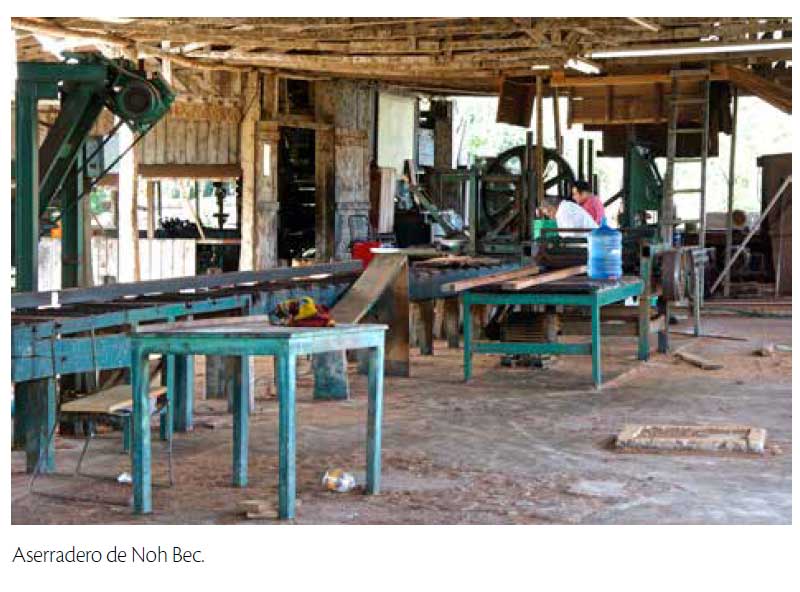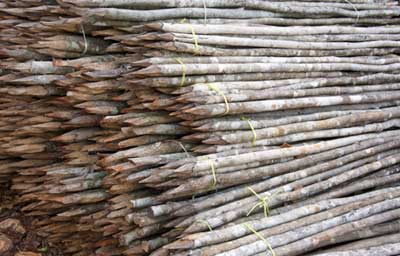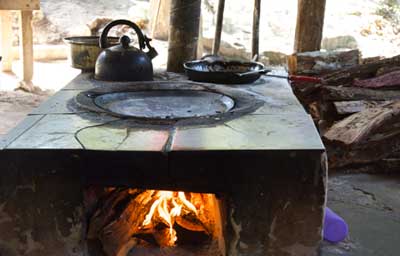Una alianza de ejidos para el manejo forestal sostenible

Mientras en muchos lugares de Mesoamérica la caoba prácticamente se ha extinguido, la Selva Maya es uno de los últimos refugios donde aún se encuentra en densidades y volúmenes aprovechables. El Estado de Quintana Roo tiene más de un siglo de historia de aprovechamiento forestal, principalmente de caoba, pero también de cedro (actualmente protegido) y la extracción de chicle del zapote. En sus inicios el aprovechamiento forestal estuvo en manos privadas, o bajo régimen de concesión como fue el caso de la empresa MIQRO, pero hoy se encuentra en su mayor parte bajo la administración de ejidos. Muchos de estos ejidos, con acompañamiento técnico, han logrado hacer un manejo sustentable del recurso forestal, alcanzando un equilibrio entre la viabilidad económica de la actividad y la conservación. Sin embargo, en menos de una década las condiciones del mercado han cambiado, y muchas empresas forestales han comenzado a decrecer en sus ganancias, al punto de comenzar a amenazar la actividad. Es importante señalar que el manejo sustentable de la selva ha demostrado ser una de las herramientas más efectivas para la conservación, y está suficientemente documentado que cuando su manejo deja de ser rentable, se abandona y comienzan los eventos de degradación y deforestación, ya sea por la falta de interés en el recurso o por el cambio de uso del suelo por otras actividades como la agricultura o la ganadería. Aquí radica la importancia de realizar esfuerzos para que el manejo de las selvas de Quintana Roo siga siendo una alternativa rentable, y con esto garantizar la perpetuidad de este recurso. En ese contexto, y con el acompañamiento de organizaciones como Trópica Rural Latinoamericana AC y U’yo’olché AC, cinco ejidos del sur de Quintana Roo han tomado la iniciativa de constituir una Alianza de Ejidos Forestales con el claro objetivo de dar un nuevo impulso a la actividad, convencidos de que el aprovechamiento forestal es una de las herramientas más efectivas para la conservación de la Selva Maya.
Felipe Carrillo Puerto, Noh Bec, Petcacab y su Anexo Polinkin, X-Hazil y Anexos, y Bacalar son cinco ejidos del sur de Quintana Roo con historias muy diferentes, pero tienen algo en común que alguna vez generó competencia y hoy los une: su gran riqueza forestal. En 1983, el Plan Piloto Forestal fue un primer intento para fomentar el aprovechamiento sustentable de las maderas de esta región, y logró impulsar una vocación forestal en muchos de sus habitantes. Trópica Rural Latinoamericana (TRL) es una organización que ha trabajado con los ejidos forestales desde sus inicios; por ejemplo en el año 1998 elaboró el plan de manejo forestal del ejido Noh Bec. Según cuenta Abraham González Sosa, ejidatario de 34 años e ingeniero forestal, ese fue el inicio de unos tiempos dorados. En el año 2009 Abraham era tesorero en el ejido, y cuenta que en 2006 se exportaba madera de katal’ox y chakte cok a Suecia y Alemania, luego en 2008 se exportó madera certificada FSC de caoba, granadillo y ciricote a Estados Unidos, Japón e Italia. Hubo un imprevisto que cambió radicalmente el enfoque, cuenta Claudia Palafox de TRL, porque casi todos los programas de manejo de los cinco ejidos forestales tenían que ser renovados en 2008, pero el huracán Dean en 2007 tuvo un impacto inesperado, se perdió mucha biomasa forestal y los volúmenes aprovechables ya no fueron los mismos. No todos los ejidos fueron afectados por igual, pero ese año se sumó una gran sequía que derivó posteriormente en grandes incendios forestales. Ante un escenario con menores volúmenes de madera, aumento en los costos de operación debido al aumento del diesel y una baja en el precio de la madera, el mercado se hizo altamente competitivo y los ejidos forestales comenzaron a competir con precios cada vez más bajos, cuenta don Elías Be Cituk, ex presidente del Comisariado Ejidal de Felipe Carrillo Puerto. “Era evidente que necesitábamos ponernos de acuerdo con los precios de la madera, por eso en 2011 comenzamos a gestionar la creación de una Alianza de Ejidos Forestales”. “Los ejidos se dieron cuenta de que era necesario estar unidos para hacer frente a problemas comunes”, explica José Antonio Arreola Palacios, director de U’yo’olché, “porque si bien lo medular es el manejo forestal, hay cuestiones de tipo agrario, administrativos y fiscales que sería más conveniente trabajarlas de manera coordinada”. “Por ejemplo, explica don Elías, los estudios de impacto ambiental son muy costosos, y si estamos unidos es posible hacer uno solo que abarque a los cinco ejidos. Pasa lo mismo con la certificación del Forest Stewardship Council (FSC) otorgada a las operaciones forestales que cumplen con estándares ambientales, económicos y sociales, que hoy solo lo tienen Caobas que aún no forma parte de la alianza, y Noh Bec, en tanto que Petcacab lo estaría recibiendo este año”.
Entre 2011 y 2012 se realizaron una serie de reuniones para comenzar a dar forma a la propuesta de la Alianza de Ejidos Forestales. El ejido Noh Bec fue uno de los primeros impulsores, también Felipe Carrillo Puerto, y luego Petcacab, Bacalar e X-Hazil. Caobas es otro ejido con tradición forestal que tiene interés en incorporarse a la Alianza, pero aún no tiene acuerdos formales. “TRL ha sido el eje central en la conformación de la Alianza”, dice don Clementino Ku Pakab, actual presidente del Comisariado Ejidal de Carrillo Puerto, ya que ha sido quien se encargó de convocar a todas las reuniones, y su director Alfonso Argüelles ha hecho una labor incansable en fortalecer el manejo forestal de los cinco ejidos, así como el ingeniero José Antonio Arreola que también ha impulsado este proyecto. Durante el año 2014 se llevó a cabo el proceso de nombrar a los delegados de cada ejido por medio de asambleas, explica Claudia Palafox. Como es una unión de ejidos se va a manejar como una asamblea con sus delegados, que a su vez son los presidentes de los cinco comisariados ejidales. Esta estructura daría transparencia a la alianza, en parte debido a que las decisiones no pueden ser unilaterales. Si bien la alianza tiene un director ejecutivo que la administra, las decisiones se toman de forma consensuada por el consejo de administración, integrado por los presidentes de los comisariados ejidales, se informa a los delegados, y estos llevan la información a las asambleas ejidales. Don Elías Be Cituk fue uno de los impulsores de la alianza en los ejidos, explica Clementino, actualmente presidente ejecutivo de la alianza, pero ha sido un largo camino para que se pueda consolidar. “Aún no está terminado el trabajo, pero ya figura en el registro público y tenemos el alta en Hacienda, en estos primeros días de 2015 se apertura la cuenta y comenzamos a operar como Alianza Selva Maya de Quintana Roo”. “La alianza ya es un hecho, menciona don Clementino, nadie se opuso en el proceso, todos nos inyectábamos de optimismo en las reuniones, siempre supimos que era algo que beneficiaría a los cinco ejidos”. La conformación de la alianza es un gran paso hacia adelante, pero han tenido que pasar cinco años para que se legalice y empiece a funcionar como tal, menciona Abraham González Sosa. En parte es debido a que cuando cambian las autoridades ejidales, y por lo tanto de delegados ante el consejo, hay que comenzar con el proceso de actualización sobre los avances, por eso es recomendable tener paciencia, pero vale mucho la pena. En ese sentido, explica Arreola Palacios, “algunas instituciones pusieron mucha voluntad en acelerar la formación de la alianza, pero nosotros nos opusimos porque consideramos que se trata de un proceso por el que deben pasar las comunidades hasta apropiarse de la iniciativa, de esa manera puede tomar más tiempo pero es más legítimo. El proceso es lento, hay que tener en cuenta que se manejan temas delicados como transparencia y rendición de cuentas, por eso construir confianza no es de un día para otro”. “Algunos ejidos forestales han mostrado desánimo con la actividad”, dice Arreola, “porque ya no tienen los volúmenes maderables que había hace 40 años”. Las razones se pueden buscar en técnicas de manejo, la industria, el mercado, todos aspectos que quizás no se hayan desarrollado adecuadamente en algunos casos. Está totalmente demostrado que los ejidos que cuentan con buen manejo forestal son los únicos que mantienen una selva saludable. “Hay muchos ejidos cercanos que no tienen plan de manejo y han acabado con sus recursos, es por ello que mediante el buen manejo del bosque no solo conservamos el recurso, sino que se mantienen los medios de vida de las comunidades, y es necesario buscar alternativas para que eso no se pierda”. Es muy importante dar un nuevo impulso a la actividad forestal, y la Alianza es una plataforma idónea para eso.
|






















